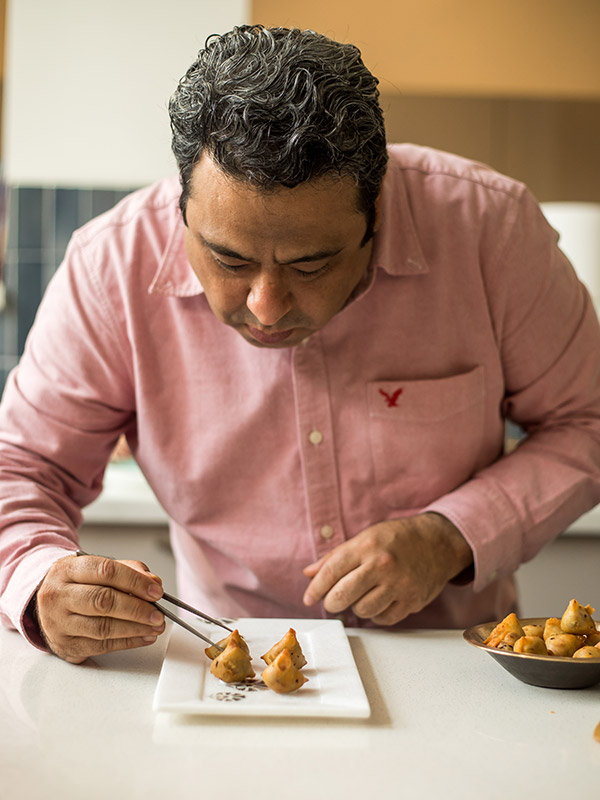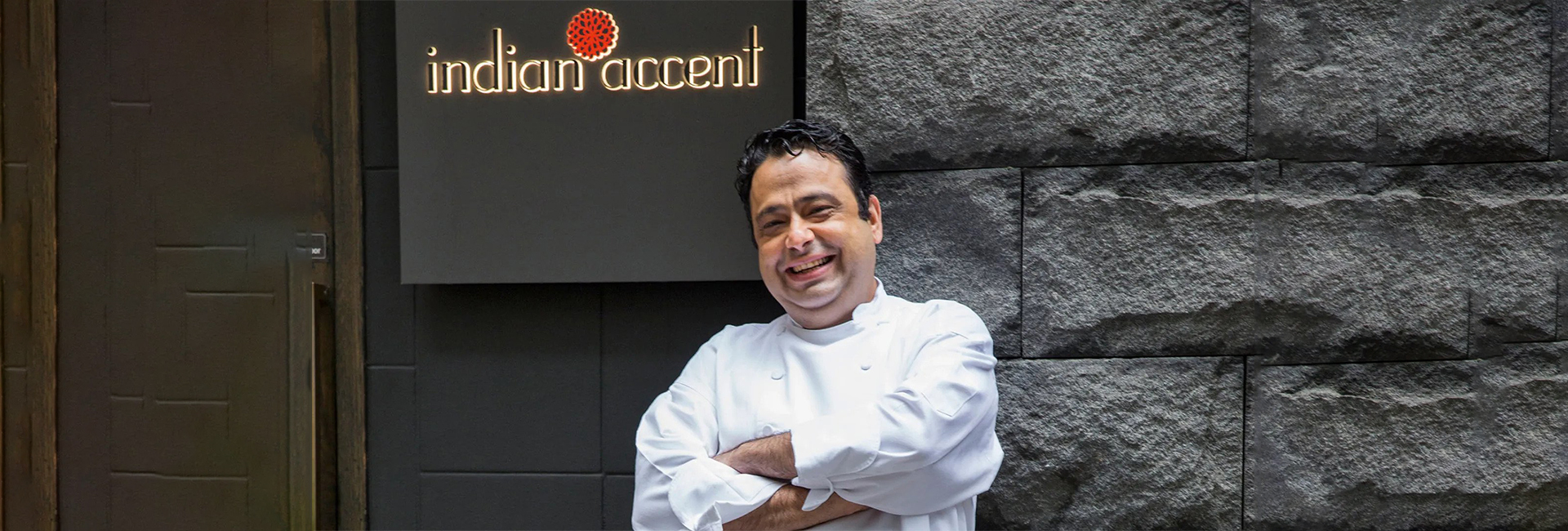(May 17, 2023) It was in 2009 that Chef Manish Mehrotra opened the doors of Indian Accent to Dilliwallas, a fine-dining Indian restaurant that in no time became a phenomenon, taking over New York and London. If the chef took Delhi’s iconic Daulat ki Chaat to New York, he introduced Indians to the Blue Cheese Naan and changed the way people perceive Indian food. It’s this uniqueness that has yet again put Indian Accent on Asia’s 50 Best Restaurants list for the 10th consecutive year. This year, his restaurant jumped three spots – from #22 to #19. For someone who enjoys bringing unique combinations to street chaat and regional cuisine, his unconventional approach to Indian food has made him stand tall.
“I am eternally grateful for all the titles, but at the end of the day what matters to me is when someone walks out happy from my restaurant. They come with high expectations about the name, and it’s my job to fulfill it. Once you know you’ve done it, you’ve reached success,” he told Elle. Manish’s story is one of unyielding passion, relentless innovation, and profound respect for his culinary heritage.

The celebration of food
The Patna-born spent most of his childhood in the city. Though never the one to be seen in the kitchen, he enjoyed the food as it was something that was celebrated at his home. It was in the early 80s that he had his first fine dining encounter, and it had him hooked. So, when the time came to pursue a career, he picked hotel management as “it was then in fashion.” This led him to the gates of the Institute of Hotel Management, Mumbai where he honed his culinary skills. It was here that he fell in love with food production. “When I joined my school, I found their kitchen the most interesting place. That is when I decided I want to become a chef,” he said in an interview.
He kickstarted his career as part of Ananda Solomon’s team at the Thai Pavilion of the Taj Hotels, where he mastered the art of pan-Asian cuisine. Manish, who calls his mentor Chef Ananda – one of the finest chefs, learnt a great deal from him, one of the most important lessons being how to understand the guests’ psyche. “That is what I learnt from Chef Ananda Solomon and that is what I still believe in. I still believe in feedback. One golden rule that I learnt from Chef Ananda is the plate that goes inside the restaurant was very important but the plate that comes back from the restaurant is even more important. He added that one can make out from the amount of food that is left on the plate whether someone liked the food or not,” he told HT.

Indian cuisine with a twist
Working under the guidance of Solomon, Manish began to understand the depth and diversity of Indian cuisine. Solomon’s meticulous attention to detail, insistence on quality ingredients, and reverence for traditional cooking methods profoundly influenced Mehrotra. He learned the importance of balancing flavours and respecting the integrity of each ingredient, principles that would later become the bedrock of his culinary philosophy.
Later, he joined Old World Hospitality Oriental Octopus and travelled across Asia to train in Pan Asian Cuisine. He embarked on a journey to redefine and elevate Indian cuisine. He began to experiment, fusing traditional Indian flavours with contemporary culinary techniques to create dishes that were both familiar and remarkably innovative. His unique approach caught the attention of food enthusiasts across the globe, leading to the birth of Indian Accent.

The inspiration came while working in London when the Global Indian found that there was a huge disconnect between the youth of the time (2008-9) and Indian foods. And it was this gap that he wanted to fill in with Indian Accent. “London at that point in time was more than New York; it was a cosmopolitan city of a different culture, different nationality, and everyone’s food was represented in that city at a different level and on a very good level also. Indian food chefs like Vineet Bhatia, Chef Atul Kochhar, Vivek Singh… they were all doing fantastic work and when you saw their work you got inspired, then you say why can’t you do this kind of thing in India. Because one thing that I felt at that point of time was that the youth of India had a very big disconnect with Indian food at that point of time. Young Indians had stopped going to Indian restaurants and there was a big disconnect. That was one motivation that you have to do Indian food in such a way that it reconnects the young generation also,” he said, adding, “The people coming outside India can relate to it and cuisine can move forward. The regional cuisine can come to limelight.”
Putting Indian food on global map
With dishes as unique as Blue Cheese Naan, Doda Barfi Treacle Tart, and Meetha Achaar Pork Ribs on the menu, Manish saw an empty restaurant for the first few months. Since Indian Accent was nothing like any other Indian restaurant serving regular Indian khaana, many people would walk out after reading the menu. However, things started slowly picking up for the chef as people understood the concept. “Now, people are open to experimenting. With increase in travel, palettes have evolved and are ready to experiment. It will take more time but it’s a good progress.”
View this post on Instagram
Indian Accent, under his expert guidance, became a culinary sensation. The restaurant’s innovative menu beautifully showcases the chef’s understanding of Indian cuisine, while the novel presentations highlight his modern, inventive touch. Each dish is a testament to his ability to transform traditional recipes into contemporary masterpieces without compromising on authenticity.
In 2016, he decided to take Indian Accent to New York, a landscape that’s already familiar with upscale Indian dining and created quite a stir by introducing Delhi’s iconic Daulat ki Chaat to New Yorkers. With no previous exposure in the US, starting anew in unfamiliar scenery was challenging for the chef. However, it helped him push the creative envelope. But what surprised him the most was the reception that Indian Accent got in New York. “People already knew about Indian Accent New Delhi; they’d been there, or their friends and family had been there and they’d told them about it. That doesn’t make New York City easy to negotiate, of course: If this city doesn’t like something, it can be ruthless,” he said.
View this post on Instagram
Manish’s ten-year streak on the Asia’s 50 Best Restaurants list is a testament to his culinary prowess and the consistent excellence of his Indian Accent. His remarkable journey from a young boy in Patna to an internationally recognized chef is not just the result of his talent and dedication but also his ability to re-imagine Indian food in a way that resonates with a global audience.
He has pushed the boundaries of what is considered Indian cuisine, transforming it from a largely misunderstood food culture into a globally recognized and respected culinary art form. Mehrotra has not only changed how the world perceives Indian cuisine but also inspired a generation of budding chefs to explore the rich tapestry of Indian flavours and techniques. “Our ultimate goal is to get real Indian food to the world and tell the world that India is not wholly about the northwest frontier. There is east, west, south, every different part of India has a unique cuisine to offer which is happening.”
Manish, who is a self-proclaimed movie buff, enjoys South Indian-dubbed movies, along with listening to music and watching cricket. Moreover, he is an enthusiastic reader and has a collection of more than 1200 Cookbooks from across the globe.
As Indian Accent continues to dazzle the culinary world, one can’t help but admire the man from Patna who dared to reimagine Indian food, leaving an indelible Indian Accent on the world’s culinary map.
